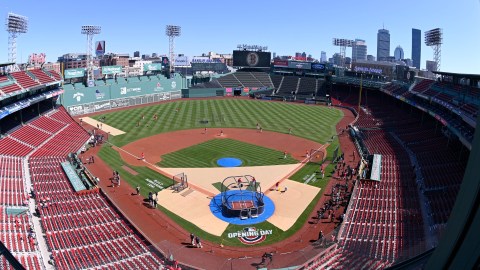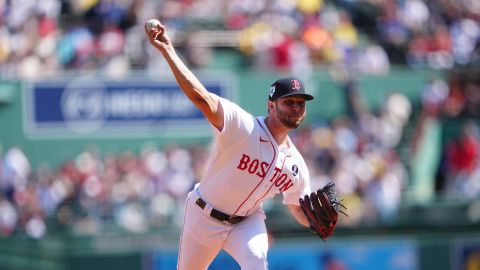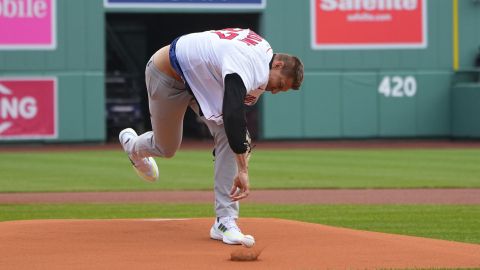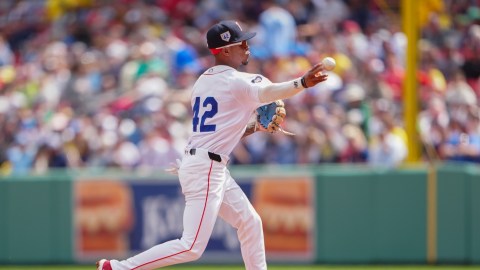 Editor’s note: Michael Narracci is the coordinating director of Red Sox broadcasts on NESN and has spent 14 seasons with the network. This is the fourth installment of his “Director’s Cut,” a behind-the-scenes look at NESN’s Red Sox game coverage.
Editor’s note: Michael Narracci is the coordinating director of Red Sox broadcasts on NESN and has spent 14 seasons with the network. This is the fourth installment of his “Director’s Cut,” a behind-the-scenes look at NESN’s Red Sox game coverage.
I’ve been the director of Red Sox baseball at NESN since June 1, 2001. When I meet new people, and they ask what I do, the next question almost always is: “So what do you actually do?”
I usually laugh and say, “Whatever the producer, talent and host of others tell me to do.”
There are many types of directors. There is the most recognizable motion-picture director, but then there are live-event entertainment directors, entertainment serials, nightly news directors and the group I belong to: sports directors. I like to think we’re a special group of television professionals who are reliant on instinct, adaptability and ability to deal with stressful situations. Most of the other directors are able to block their shows, rehearse, and — in some cases if something goes wrong — “fix it in post.”
But live events are non-scripted, and there is no margin for error. It’s a nightly adrenaline rush, and that’s what makes it fun.
So, getting back to the original question: What exactly do I do?
I usually use the analogy of a symphony. The producer is the composer — he comes up with what we want to do — and I am the conductor. I try to get our orchestra (crew, cameras, audio, replay people) to make beautiful music (great TV).
My job starts with camera placement. I have to decide where in the park I want to put my cameras in order to make a great broadcast. This really isn’t as complicated as it seems. We have in the industry the “basic six or seven” cameras. They are:
Camera 1: Low third
Camera 2: High home
Camera 3: High first
Camera 4: Center field
Camera 5: Low first
Camera 6: Tight center field
Camera 7: High third
After the basic seven, you place cameras where you think they will most benefit viewers. At Fenway Park, those positions are mid first, mid home, bullpen robotic, high right field and an RF (wireless) handheld. We also have a mid third camera for select broadcasts. I’m currently working with our engineering department to develop a housing for another specialty camera that we will integrate into the broadcast in the near future.
Next, I have to come up with a coverage plan. Each camera has its individual coverage responsibility that it must follow in order for the broadcast to have a chance to succeed. I have a camera meeting with my crew about four hours before first pitch to explain what I expect them to do. For the most part, coverage is the same from director to director, but each adds his or her own subtle nuances. For instance, one thing I insist on is when we first see the batter, I really like to see him head to toe with the catcher and a bit of the umpire in the shot, before the camera zooms in to his face.
Below are some brief, routine coverage shots for my show. It’s extremely important that everyone follows his or her camera assignments. If they don’t, when a complicated play develops, I will have no chance presenting it to the viewers.
Camera 1
Left-handed batters
Right-handed pitcher or low right infield defense on right-handed batters
Trail runner
Camera 2
Follow the ball loosely
Camera 3
Follow the ball tightly
Infield and outfield heroes
Shoot anybody the announcers are talking about
Camera 4
Pitcher/Batter
Pull on stolen base
Follow batter to first base on a walk
Camera 5
Right-handed batters
Lead runner, score all runs
Pitcher (tight) or right defense on left-handed batter
Camera 6
Batter
Camera 7
Ball follow tightly
Cover right field corner
Camera 8 and 9
Ball follow loosely with relativity to runner
Before the season begins, I work with our creative services department to develop a variety of animated wipes (also known as “eye candy”) that we use for replays and transitions to elements such as lineups and full-page graphics. It adds a little more energy to the broadcast than just cutting or dissolving to these elements. When we get to a ballpark, I sit with the technical director (or TD) and explain our effects to him or her, so they can build the show on the switcher and other peripheral devices that we use to make the show work.
Next, I lay out my monitor wall in the truck, which is a rolling TV studio. Generally, there are between 75 and 100 monitors in the truck that we put all of the video sources available to us in. This would include cameras, tape machines, graphics, transmission router and the other team’s broadcast (we like to look in on what they’re doing, in case our camera guys miss something). Our camera guys are our eyes in the park, so if they don’t shoot something that’s happening, we can’t see it. Our other eyes are Don Orsillo and Jerry Remy in the booth. 
Everyone lays out their monitor wall a little differently. I lay mine out so that the cameras on the left side of the field (third base) are on the left side of my bank of monitors, and the cameras that are on the right side of the field are on the right side of the monitor wall. The engineers can store these monitor wall settings for us so the next time we use the truck, our set-up will be quicker. Time is a precious commodity on remotes, so any way we can save some is greatly appreciated. Any bump in the road — such as a camera that won’t work, or a graphics machine that malfunctions — has pretty big consequences physically, mentally and financially.
Once we’re on the air, it’s my job to tell the story that the producer develops with my crew and talent. If Don is talking about the pitcher, I want to show the pitcher to reinforce the story. I also might want to cut to a shot of the pitching coach if he’s a part of the story (such as if he’s going to the phone to call the bullpen), then show the bullpen if a guy is getting up to warm up. We call that enhancement.
Producer Jim Daddona does the same thing I do, but with our replay sources. He listens to Jerry and uses his judgment as to what’s the most comprehensive and educational sequence of replays. At very exciting points in the game, I start talking like an auctioneer, moving camera shots around and instructing the TD what source I want on air to tell the story, because there is a finite amount of time between pitches and I want to be comprehensive (pitcher, batter, runners, crowd, managers, etc.).
It’s a big responsibility that I have to bring the sights and sounds of Red Sox baseball to fans everywhere. We are, of course, on cable and satellite in New England, but we often are on in Japan with our partners from NHK and other parts of the world with MLB International. It has been a blast doing this job for the past 14 seasons, and I have been fortunate to be here in what has been a very successful period for the team. I hope to continue to do this for a long time to come.



